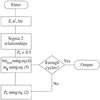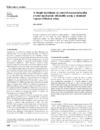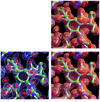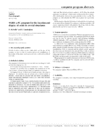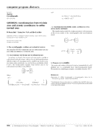issue contents
June 2000 issue

Cover illustration: Reorientation pathways of the octahedral PF6 anion in KPF6, calculated by an evolution algorithm. Courtesy of K. Knorr (University Kiel, Earth Sciences - Mineralogy) and Fritz Mädler (HMI Berlin) [J. Appl. Cryst. (1999), 32, 902-910].
research papers
Improvement of SAXS measurements on Kratky slit systems by Göbel mirrors and imaging-plate detectors
An improved laboratory SAXS camera based on the Kratky slit system is presented. The divergent X-ray beam is collimated by a Göbel mirror and image-plate detection guarantees linear response even though the intensity is increased by a factor of ten.
The anomalous signals from scatterers such as sulfur and arsenic have been compared in diffraction data sets collected from an X-ray source with three different targets, Au, Cu and Cr, on a multi-target rotating anode.
The design and performance of a high-flux X-ray crystallography system, optimized for diffraction measurements from small macromolecular crystals, is described. This system combines a 40 W X-ray generator with a polycapillary collimating optic.
The use of the quasicrystals as crystal analysers has been studied in monochromatic X-ray synchrotron radiation applications. The efficiency of the combination of periodic and quasiperiodic crystals for harmonic rejection is demonstrated.
The determination of three-dimensional reflection coordinates for an area-detector diffractometer equipped with an Euler or Kappa goniostat is presented. The method is based on comparison of related images obtained from two crystal rotations such that the same reflections are registered, but on different positions on the detector.
Techniques and methods to facilitate the solution of structures by simulated annealing have been developed from the starting point of a space group and lattice parameters.
A study of the phase transitions in Na0.5Bi0.5TiO3 using a new microscopy technique for birefringence imaging is presented.
Long-chain lead alkanethiolates prepared from pure mercaptans provide numerous sharp long-spacing and low-order lines and also very many strong high-order lines between the lines of silicon standard reference material. The resulting statistical accuracy thus extends exact calibration of X-ray diffractometers to intermediate and large d values without other validation or data.
Analytical expressions for the absolute change of the primary reflection intensity due to multiple diffraction are given in the kinematical approach. It is shown that satisfactory agreement between experiment and theory can be obtained for a mosaic (diamond) as well as for a perfect crystal (silicon) even in the case of strong reflections.
Single crystals of Cu–2.5 at.% Ti have been studied by small-angle and large-angle X-ray scattering to determine the displacements induced by the formation and the coarsening of ordered Cu4Ti precipitates. The variation of the atomic scattering factor of Cu near its absorption edge was used to confirm the nature of the precipitates and to show that the scattering appearing near Bragg peaks was due to the displacements of the atoms from their positions, induced by the formation of the precipitates, and not to the segregation of the Ti atoms.
A method is proposed to eliminate the systematic error in the high-accuracy universal polarimeter and so obtain good values for the ellipticity in birefringent sections of, for example, a KDP crystal.
Boules of industrial blue corundum produced using the Verneuil process are single crystals only in the initially grown parts. From the middle of the boule the samples show a macromosaic texture.
A setup for synchrotron X-ray powder diffraction on samples with high absorption (μR > 10) is described.
A method for direct-space determination of the basis matrix, particularly for protein crystals of comparatively low quality, is described. The method is based on three-dimensional Fourier analysis in reciprocal space.
A procedure for determining crystallite size distributions, based on theoretical considerations and whole-powder-pattern modelling, is compared with methods of line-profile analysis in which reflections are approximated by an analytical function.
teaching and education
Free 

An EXCEL (Microsoft Corp.) workbook has been configured to enable spreadsheet calculation of two-dimensional structure factors and Fourier syntheses. An exercise in which it can be used by undergraduate students to solve the structure of potassium bicarbonate in projection is described.
short communications
The background contribution in powder diffraction patterns is estimated by averaging intensities over large portions of the diffractogram. Bragg peaks are thus treated as `noise', a particular kind of noise being present only as an excess intensity.
computer programs
OASIS applies a direct-method procedure to break the phase ambiguity intrinsic to one-wavelength anomalous scattering or single isomorphous replacement data.
A computer program which attempts to automate the procedure of calculating maximum-entropy maps while providing a useful graphical output of the current stage of the calculation has been developed.
laboratory notes
An air-filled ionization chamber with a three-way split anode can be used to measure the tilt and the translation of a collimated X-ray beam with respect to the chamber axis.
Macromolecular crystals with dimensions suitable for data collection can be reproducibly obtained by releasing, for a discrete amount of time, the vapour pressure in both hanging- and sitting-drop experiments, set up at lower precipitant concentrations than those required for crystallization.
computer program abstracts
CONSCRIPT provides a tool for rendering protein electron density as a transparent Gouraud-shaded surface suitable for high-quality display in printed and electronic journals.
A new program in the suite of Tcl/Tk-based programs has been developed as a specialized tool for crystallographic calculations.
The program VOID provides facilities both for searching for voids, which may be part of the crystal structure or may be due to missing solvent of crystallization, and for their display on a PC.
The program ORTHON transforms any non-orthonormal cell data and atomic coordinates to orthonormal data.


 journal menu
journal menu




























